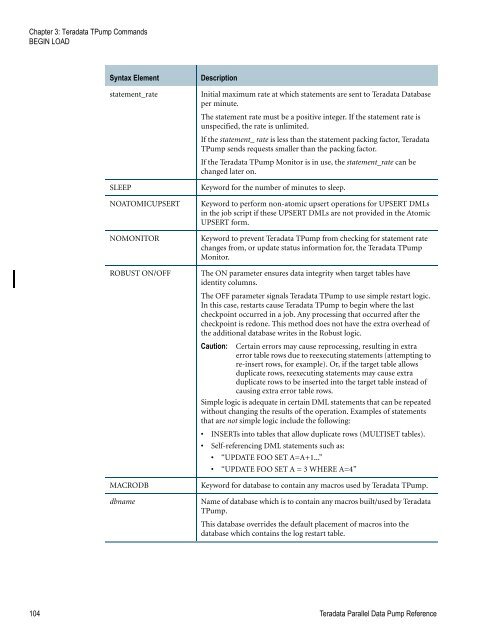Teradata Parallel Data Pump
Teradata Parallel Data Pump Reference - Teradata Developer ...
Teradata Parallel Data Pump Reference - Teradata Developer ...
- No tags were found...
You also want an ePaper? Increase the reach of your titles
YUMPU automatically turns print PDFs into web optimized ePapers that Google loves.
Chapter 3: <strong>Teradata</strong> T<strong>Pump</strong> Commands<br />
BEGIN LOAD<br />
Syntax Element<br />
statement_rate<br />
Description<br />
Initial maximum rate at which statements are sent to <strong>Teradata</strong> <strong>Data</strong>base<br />
per minute.<br />
The statement rate must be a positive integer. If the statement rate is<br />
unspecified, the rate is unlimited.<br />
If the statement_ rate is less than the statement packing factor, <strong>Teradata</strong><br />
T<strong>Pump</strong> sends requests smaller than the packing factor.<br />
If the <strong>Teradata</strong> T<strong>Pump</strong> Monitor is in use, the statement_rate can be<br />
changed later on.<br />
SLEEP<br />
NOATOMICUPSERT<br />
NOMONITOR<br />
ROBUST ON/OFF<br />
Keyword for the number of minutes to sleep.<br />
Keyword to perform non-atomic upsert operations for UPSERT DMLs<br />
in the job script if these UPSERT DMLs are not provided in the Atomic<br />
UPSERT form.<br />
Keyword to prevent <strong>Teradata</strong> T<strong>Pump</strong> from checking for statement rate<br />
changes from, or update status information for, the <strong>Teradata</strong> T<strong>Pump</strong><br />
Monitor.<br />
The ON parameter ensures data integrity when target tables have<br />
identity columns.<br />
The OFF parameter signals <strong>Teradata</strong> T<strong>Pump</strong> to use simple restart logic.<br />
In this case, restarts cause <strong>Teradata</strong> T<strong>Pump</strong> to begin where the last<br />
checkpoint occurred in a job. Any processing that occurred after the<br />
checkpoint is redone. This method does not have the extra overhead of<br />
the additional database writes in the Robust logic.<br />
Caution: Certain errors may cause reprocessing, resulting in extra<br />
error table rows due to reexecuting statements (attempting to<br />
re-insert rows, for example). Or, if the target table allows<br />
duplicate rows, reexecuting statements may cause extra<br />
duplicate rows to be inserted into the target table instead of<br />
causing extra error table rows.<br />
Simple logic is adequate in certain DML statements that can be repeated<br />
without changing the results of the operation. Examples of statements<br />
that are not simple logic include the following:<br />
• INSERTs into tables that allow duplicate rows (MULTISET tables).<br />
• Self-referencing DML statements such as:<br />
• “UPDATE FOO SET A=A+1...”<br />
• “UPDATE FOO SET A = 3 WHERE A=4”<br />
MACRODB<br />
dbname<br />
Keyword for database to contain any macros used by <strong>Teradata</strong> T<strong>Pump</strong>.<br />
Name of database which is to contain any macros built/used by <strong>Teradata</strong><br />
T<strong>Pump</strong>.<br />
This database overrides the default placement of macros into the<br />
database which contains the log restart table.<br />
104 <strong>Teradata</strong> <strong>Parallel</strong> <strong>Data</strong> <strong>Pump</strong> Reference









